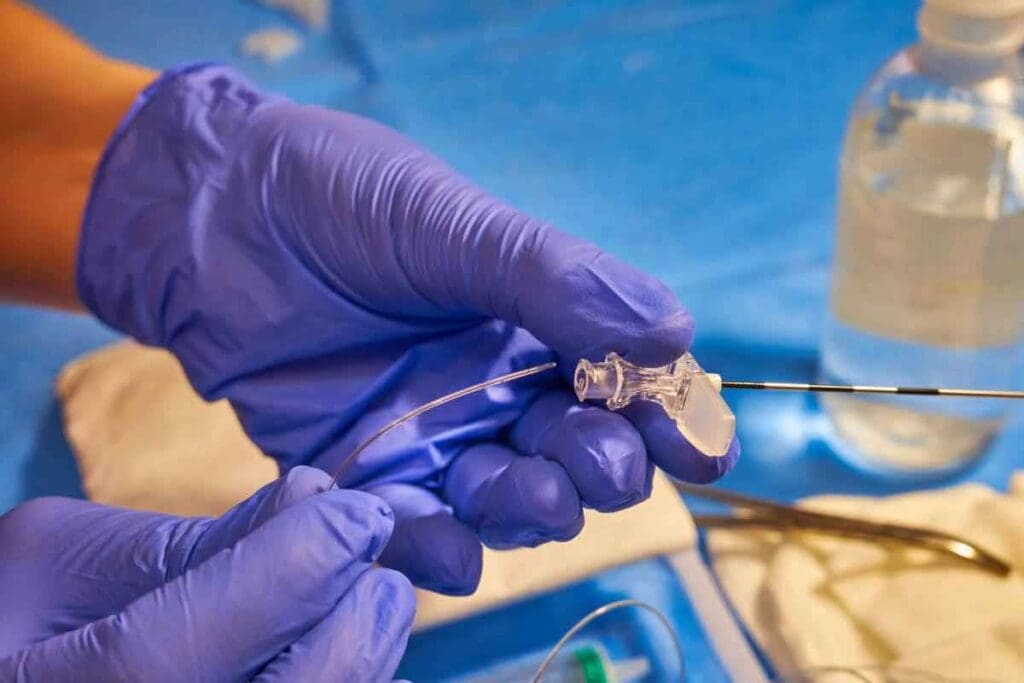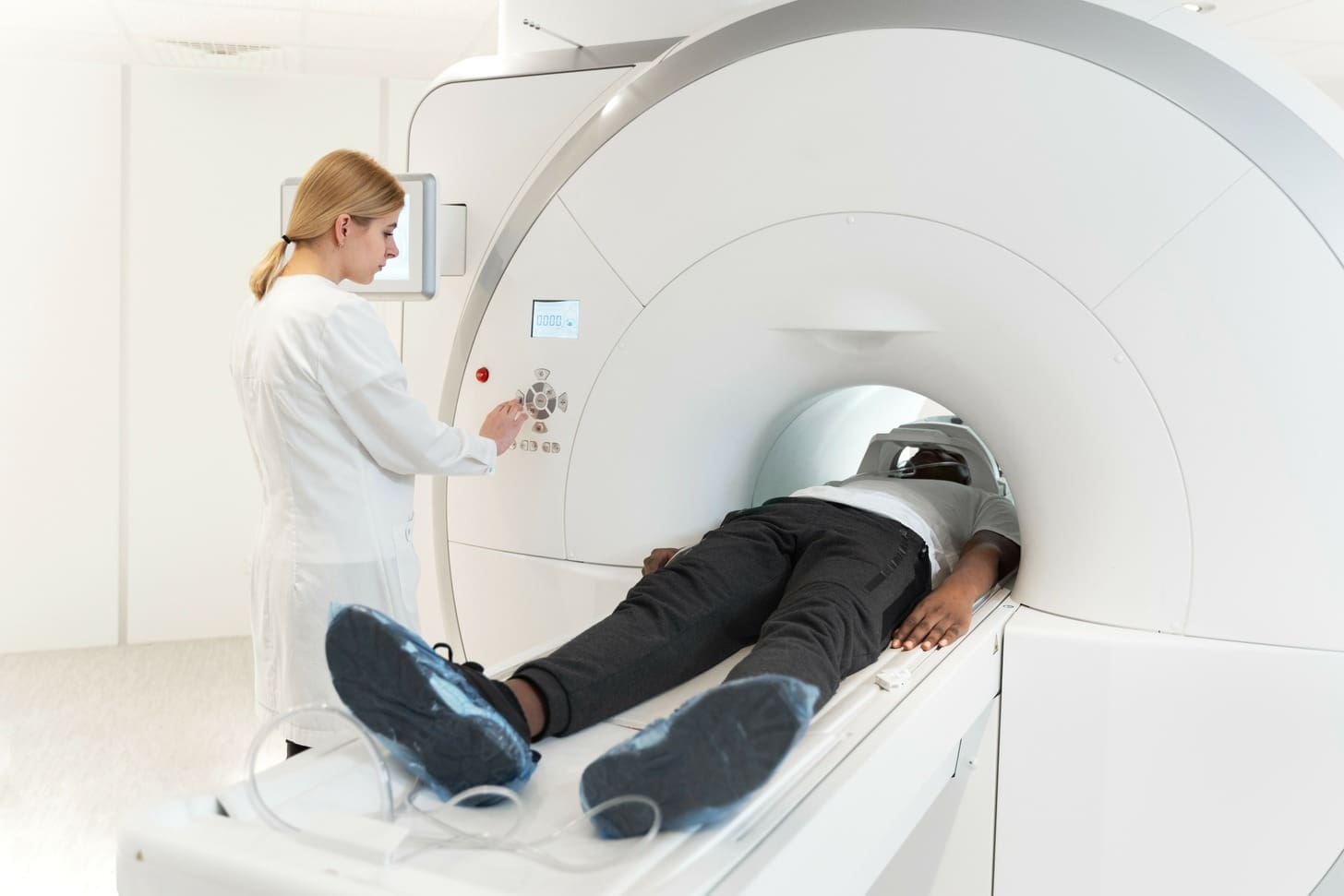Last Updated on November 26, 2025 by Bilal Hasdemir

At Liv Hospital, we use caudal epidural steroid injections to treat pain in the lower back and legs. This method is great for people with long-term back pain and pain that spreads to the legs.
So, what is a caudal injection? It’s a special kind of epidural steroid injection. It’s given through the sacral hiatus to help with pain and swelling. Knowing about caudal ESI injections helps patients choose the best treatment for them.
Key Takeaways
- Caudal epidural steroid injections target the lower back and legs.
- The procedure involves delivering medication via the sacral hiatus.
- This treatment is effective for chronic lower back pain and radiating leg pain.
- Caudal ESI injections are a non-surgical solution for pain management.
- Patients can experience significant relief from pain and inflammation.
What Is a Caudal Epidural Steroid Injection?

The caudal epidural steroid injection is a special procedure to help with pain and swelling in the lower back. It puts medicine into the epidural space through the sacral canal. This helps with many spinal problems.
Definition and Purpose of Caudal Epidural Injections
Caudal epidural steroid injections put corticosteroids and local anesthetics into the epidural space. They go in through the sacral hiatus. The goal is to lessen pain and swelling in the lower back and legs.
This is helpful for issues like lumbar radiculopathy, spinal stenosis, and disc herniation.
Medications Used in Caudal ESI
The medicines used in caudal epidural steroid injections include a corticosteroid and a local anesthetic. The corticosteroid reduces swelling, and the local anesthetic gives quick pain relief. Together, they help manage pain both short-term and long-term.
Historical Development of the Procedure
Epidural steroid injections, including the caudal method, have been around for pain relief. They were first used in 1952. Over time, better imaging tools like fluoroscopy and ultrasound have made the procedure safer and more accurate.
| Procedure Aspect | Description |
| Medications Used | Corticosteroids and local anesthetics |
| Injection Location | Sacral canal below the sacrococcygeal ligament |
| Primary Purpose | Reduce inflammation and pain |
| Historical Use | 1952 |
Anatomy of the Caudal Spine and Sacral Region

The caudal spine and sacral region are key in pain management. They are easily reached and effective for treatments. This makes them important for pain relief.
Understanding the Sacral Hiatus
The sacral hiatus is a key spot in the sacrum. It’s the bottom opening of the sacral canal. It’s flanked by two sacral cornua and covered by the sacrococcygeal ligament. This spot is vital for getting to the epidural space during injections.
The Sacrococcygeal Ligament and Surrounding Structures
The sacrococcygeal ligament covers the sacral hiatus. It’s a key part in giving caudal epidural injections. Knowing about this ligament and the surrounding areas is important for placing the injection right.
Why This Region Is Important for Pain Management
The caudal spine and sacral region are key for pain relief. They are close to nerves that carry pain from the lower back and legs. Caudal epidural steroid injections target this area. They deliver medicine to the pain source, helping with conditions like lumbar radiculopathy and spinal stenosis.
| Anatomical Structure | Significance in Caudal ESI |
| Sacral Hiatus | Provides access to the epidural space |
| Sacrococcygeal Ligament | Covers the sacral hiatus, guiding needle placement |
| Sacral Canal | Contains nerves targeted by caudal ESI |
Precise Caudal Injection Location Techniques
The success of caudal epidural steroid injections relies on accurate needle placement. We use different methods to ensure the injection is placed correctly. This is key for the caudal ESI procedure to work well.
Accessing the Epidural Space Through the Sacral Canal
We navigate through the sacral canal to reach the epidural space. Understanding sacral anatomy is essential. We must accurately find the sacral hiatus. Accurate needle placement is vital to avoid problems and make sure the medication reaches the right spot.
Fluoroscopic Guidance Methods
Fluoroscopy is a common tool for caudal epidural injections. It shows us the needle’s position in real-time. This helps us place the needle correctly and lowers the risk of complications.
Ultrasound-Guided Caudal Injections
Ultrasound guidance is also used for caudal ESI procedures. It lets us see the needle’s position without using X-rays. We use ultrasound to find the sacral hiatus and guide the needle. This ensures the medication is delivered precisely.
Both fluoroscopic and ultrasound guidance have their benefits. The choice between them depends on the patient’s anatomy and the doctor’s preference.
Caudal Injection vs Epidural: Understanding the Differences
Managing chronic pain requires knowing the differences between caudal injections and other epidural injections. Epidural steroid injections are a common treatment for spinal conditions. They come in different forms.
Entry Point Variations: Caudal, Interlaminar, and Transforaminal
The main difference is the entry point. There are three main approaches: caudal, interlaminar, and transforaminal. Caudal injections involve injecting medication through the sacral hiatus, a small opening at the base of the spine.
- Caudal injections: Medication is delivered through the sacral canal.
- Interlaminar injections: Medication is delivered between the laminae of two vertebrae.
- Transforaminal injections: Medication is delivered through the foramen, the opening through which nerves exit the spinal canal.
Target Area Differences and Medication Spread
The target area and medication spread vary between these approaches. Caudal injections have a broader spread, while transforaminal injections target specific nerves.
Caudal ESI is great for lower back pain and lower extremity conditions. The choice depends on the condition and the patient’s anatomy.
When Doctors Recommend One Approach Over Others
Doctors consider several factors when choosing between caudal and other epidural injections. These include the patient’s condition, pain location, and overall health.
- The severity and location of the patient’s pain.
- The patient’s medical history and previous responses to treatments.
- The specific condition being treated, such as lumbar radiculopathy or spinal stenosis.
Understanding these differences helps patients make informed decisions. Healthcare providers can then offer more targeted and effective treatments.
The Complete Caudal ESI Procedure Step-by-Step
Knowing how a caudal ESI works is key for those thinking about it. It has several important steps, from getting ready to giving the medicine.
Pre-Procedure Preparation and Assessment
First, patients get a detailed check-up. We look at their health history, medicines, and allergies. Then, we do a physical exam to see if the treatment is right for them.
Patient Positioning and Sterilization Protocol
Next, the patient lies on their stomach on a special table. The area is cleaned and made sterile to avoid infections. We use drapes to keep everything clean.
Needle Placement and Confirmation Techniques
We use X-rays to guide the needle into the right spot. We add dye to make sure the needle is in the right place. This ensures the medicine goes where it should.
Medication Delivery and Procedure Duration
With the needle in place, we give a mix of steroid and local anesthetic. The whole caudal ESI procedure usually takes 10 to 20 minutes, as MedStar Health says. After, patients are watched for a bit before they go home.
By knowing each part of the caudal epidural block process, patients can feel more ready for their treatment.
Medical Conditions Effectively Treated with Caudal ESI Injections
For those with certain spinal issues, caudal ESI is a hopeful treatment. It helps ease pain and boost life quality. It’s used for many spinal problems that cause ongoing pain and discomfort.
Lumbar Radiculopathy and Sciatica
Lumbar radiculopathy, or sciatica, is when nerves in the lower back get irritated or compressed. Caudal ESI injections can cut down inflammation and ease pain. Research shows they can greatly help those with this condition.
Spinal Stenosis Management
Spinal stenosis narrows the spinal canal, leading to leg pain, numbness, and weakness. Caudal ESI injections are used to manage this by reducing inflammation. They help by easing pressure on the spinal nerves.
Disc Herniation and Degenerative Disc Disease
Disc herniation and degenerative disc disease often cause back pain and nerve issues. Caudal epidural steroid injections can lessen inflammation around the affected discs and nerves. This helps manage the pain.
Failed Back Surgery Syndrome
For those with chronic pain after back surgery, caudal ESI is a helpful option. It helps manage pain that doesn’t go away after surgery.
In summary, caudal ESI injections are a flexible treatment for many spinal issues. Knowing which conditions they treat helps doctors offer better pain management plans to their patients.
Benefits and Effectiveness of Caudal Epidural Blocks
Caudal epidural steroid injections target pain in the spinal area. They are effective for chronic pain that doesn’t respond to other treatments.
Pain Relief Duration and Expectations
Studies show these injections can last several months (Source: MedStar Health). How long the pain relief lasts depends on the condition and the patient’s health.
Functional Improvement Outcomes
Patients see not just pain relief but also better function. They can move more easily and do daily tasks with less pain.
Advantages Over Oral Pain Medications
These injections offer pain relief without the side effects of oral meds. They are safer and reduce the risks of long-term harm from steroids and opioids.
Success Rates in Different Patient Populations
The success of caudal epidural blocks varies by patient and condition. They work well for lumbar radiculopathy, spinal stenosis, and disc herniation. We assess each case to see if these injections are right.
Potential Risks and Side Effects of Caudal Steroid Injections
Caudal epidural steroid injections (ESI) are usually safe. But, they can have risks and side effects. Knowing these can help you decide if this treatment is right for you.
Common Temporary Side Effects
Most people do well with caudal ESI. But, some might feel:
- Increased pain at the injection site
- Facial flushing
- Insomnia
- Temporary numbness or weakness in the legs
Rare but Serious Complications
Even though rare, serious problems can happen. These include:
- Infection
- Nerve damage
- Bleeding complications
- Allergic reactions to the medications used
To understand the risks of caudal ESI, let’s look at how it compares to other epidural methods:
| Complication | Caudal ESI | Interlaminar ESI | Transforaminal ESI |
| Infection | Rare | Rare | Rare |
| Nerve Damage | Low Risk | Moderate Risk | Higher Risk |
| Bleeding | Low Risk | Moderate Risk | Moderate Risk |
Contraindications for the Procedure
Some conditions might make caudal ESI not suitable. These include:
- Bleeding disorders or anticoagulant therapy
- Active infection or sepsis
- Known allergy to corticosteroids or local anesthetics
- Pregnancy (relative contraindication, depending on the situation)
Talking to your healthcare provider about your health and worries is key. They can help decide if caudal ESI is good for you.
Recovery and Aftercare Following a Caudal Inj
Knowing how to recover and care for yourself after a caudal epidural injection is key. Taking the right steps can make your treatment more effective and keep you comfortable while you heal.
Immediate Post-Procedure Guidelines
Right after the injection, you’ll be watched for any quick side effects. It’s best to avoid hard work for at least a day. Make sure the area where you got the shot stays clean and dry to avoid infection.
Activity Restrictions and Return to Normal Function
Resting right after the shot is important. But, you can usually get back to your usual life in a few days. Yet, don’t do heavy lifting, bending, or hard exercise for a while, as your doctor will tell you.
When to Contact Your Healthcare Provider
If you feel more pain, have a fever, or see signs of infection at the shot site, call your doctor. Also, let them know if you notice any changes in how you go to the bathroom.
Follow-up Appointments and Additional Treatments
Going back for check-ups is important to see if the shot worked. If not, your doctor might suggest more treatments to help manage your pain.
| Activity | Recommended Post-Procedure Guidelines |
| Strenuous Activities | Avoid for at least 24 hours |
| Injection Site Care | Keep clean and dry |
| Follow-up | Schedule as directed by healthcare provider |
Conclusion: Making an Informed Decision About Caudal ESI Treatment
Caudal ESI injections are a helpful treatment for chronic lower back and leg pain. The procedure injects steroids into the epidural space through the sacral canal. This helps with conditions like lumbar radiculopathy, spinal stenosis, and disc herniation.
Research shows that caudal ESI can be very effective. It offers a lot of pain relief and helps patients function better (Source: MedStar Health). When thinking about caudal ESI, it’s important to look at the good and bad sides. You should also know how it compares to other epidural injections.
For a well-informed choice about caudal ESI, talk to a healthcare expert. They can check your condition, talk about what might happen, and see if caudal ESI is right for you. Knowing about the procedure and its benefits can help you manage your pain and improve your life.
FAQ
What is a caudal epidural steroid injection?
A caudal epidural steroid injection is a procedure. It involves injecting medication into the epidural space. This is done through the sacral canal to relieve pain in the lower back and legs.
What is the purpose of a caudal ESI injection?
The purpose of a caudal ESI injection is to deliver medication. It aims to reduce inflammation and relieve pain in the affected area.
How is the caudal injection location determined?
The location for the caudal injection is found using imaging techniques. Techniques like fluoroscopy or ultrasound are used. This ensures the needle is placed correctly in the sacral canal.
What is the difference between a caudal injection and other types of epidural injections?
The main difference lies in the entry point and target area. Caudal injections enter through the sacral hiatus. Other epidural injections may enter through different points in the spine.
What are the benefits of caudal epidural steroid injections?
The benefits include effective pain relief and reduced inflammation. It also improves function. The procedure has a relatively low risk of complications when done by experienced practitioners.
What conditions can be treated with caudal ESI injections?
Caudal ESI injections can treat several conditions. These include lumbar radiculopathy, spinal stenosis, disc herniation, and degenerative disc disease.
How long does pain relief from caudal ESI injections last?
The duration of pain relief varies. Many patients experience relief for several weeks to months after the procedure.
What are the potentially risks and side effects of caudal steroid injections?
Potential risks and side effects include temporary soreness and infection. Nerve damage and allergic reactions are also possible. Serious complications are rare, though.
What is the recovery process like after a caudal injection?
Patients are advised to rest for a short period after the procedure. They should avoid strenuous activities. Following up with their healthcare provider is also important to monitor progress.
Can anyone undergo a caudal ESI injection?
No, not everyone can undergo a caudal ESI injection. Certain individuals may not be suitable due to contraindications. These include infection, bleeding disorders, or allergies to the medications used.
How do I know if caudal ESI is right for me?
Consulting with a healthcare professional is essential. They can determine if caudal ESI is the right treatment for your condition and medical history.
References
- Manchikanti, L., Hirsch, J. A., & Boswell, M. V. (2012). Epidural steroid injections in the management of chronic spinal pain: An update of evidence and guidelines. Pain Physician, 15(3 Suppl), ES235-ES255. Retrieved October 21, 2025, from https://www.ncbi.nlm.nih.gov/pmc/articles/PMC3444247/






